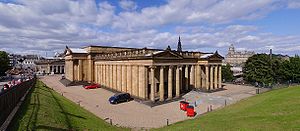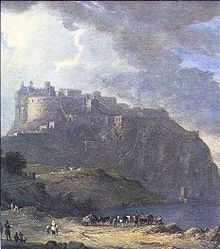- Nor Loch
-
Edinburgh Castle with the Nor Loch in foreground, around 1780 by Alexander Nasmyth

The Nor Loch, also known as the Nor' Loch and the North Loch, was a loch formerly in Edinburgh, Scotland, in the area now occupied by Princes Street Gardens, which lies between the Royal Mile and Princes Street.
Contents
Geological formation
The depression, along with the parallel one, now occupied by the Cowgate, was formed by glacial erosion during the last Ice Age, when the icepack was forced to divide by the volcanic plug now known as Castle Rock.
Early history
The Nor Loch was initially a marsh, and part of the natural defence of the Edinburgh Old Town. Because the Old Town was built on a steep ridge (still clearly visible today), it expanded on an east-west axis, eastwards from the castle; expansion northward, as would happen with the later New Town, was extremely difficult at this point. The Nor Loch was thus a hindrance to both invaders and town growth.[citation needed]
In 1460 King James III ordered the Nor Loch area to be flooded in order to strengthen the castle's defences.[1] It is thought never to have been particularly deep.
Middle Ages to 19th century
As the Old Town became ever more crowded during the Middle Ages, the Nor Loch became similarly polluted, by sewage, household waste, and general detritus thrown down the hillside. Historians are divided on whether the loch was ever used for drinking water.
The Nor Loch fulfilled a variety of other roles during this period including:
- Defence: Scotland, and particularly Edinburgh, suffered frequent English invasions during its independence.
- Witch dunking: over 300 suspected witch trials are documented at this site, as commemorated by a plaque on the castle esplanade, and it is possible that many more went undocumented. In many cases, these "trials" would have been fatal, and the suspects thus acquitted.
- Suicides: The Nor Loch was a popular spot for suicide attempts during its existence.
- Crime: The loch appears to have been used both as a smuggling route, and a site for the punishment of crime.
In 1759 the Nor Loch was drained and formed part of Princes Street Gardens, although frequent floods both then and now, threatened to "resurrect" it. For several decades after the Loch was drained, townspeople continued to refer to the area as the Nor Loch.[1]
Modern period
 The National Gallery of Scotland, built on The Mound, which is part of the infill of the former loch
The National Gallery of Scotland, built on The Mound, which is part of the infill of the former loch
Although the Nor Loch was filled in during the 19th century, neither its legacy nor its name are entirely forgotten. During the construction of Waverley Station and the railway lines through the area, a number of bones were uncovered.
Princes Street Gardens were created in the 1820s and now occupy much of the loch's former extent.
Other lost lochs in Edinburgh
The Nor Loch is not the only "lost loch" in the city. Another example is Gogarloch in the South Gyle area. Like the Nor Loch, this was mostly marshland, rather than a true loch. It was reclaimed for a park, housing and to build the railway to the Forth Bridge.
The Meadows, a large open park immediately to the south of the city centre, was once the Burgh Loch or occasionally the South Loch.
References
- ^ a b "The Nor' Loch". Edinburgh-Royalmile.com. http://www.edinburgh-royalmile.com/history/nor-loch.html. Retrieved 2007-11-02.
Further reading and references
- Fife, Malcolm. The Nor Loch, Scotland's Lost Loch (Scotforth Books, 2005)
Categories:- History of Edinburgh
- Lochs of Scotland
- Former lochs
- Old Town, Edinburgh
Wikimedia Foundation. 2010.


